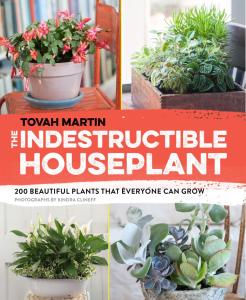The Master Gardener’s Bookshelf
The Indestructible Houseplant: 200 Beautiful Plants that Everyone Can Grow
by Tovah Martin
Review by Susan Wilhelm, Extension Master Gardener

If National House Plant Appreciation Day (Jan. 10) got you thinking about getting a house plant for the first time or if you are looking for easy-to-grow house plants to expand your existing collection, The Indestructible House Plant: 200 Beautiful Plants that Everyone Can Grow by Tovah Martin is a great resource.
Martin, an award-winning writer and self-described “house plant geek,” has extensive experience growing house plants in her own home and professionally. She worked 25 years at a nationally known tropical plant nursery where she was curator for the begonia collection and spent time caring for other plants including herbs and succulents. She wrote The Indestructible House Plant to help those who would love to have house plants but need plants that are low maintenance, look good, are readily available, and will survive in less-than-ideal growing conditions.
Martin begins The Indestructible House Plant by describing the less-than-ideal growing conditions in her own home and how she came to write the book. She also provides initial tips for determining the growing conditions in your home and selecting containers to complement your home décor.
The heart of the book is what Martin calls her “Gallery of Indestructibles,” 200 plants she says anyone can grow. The gallery includes old-fashioned plants such as Saintpaulia cultivars (African violets), aspidistra (barbershop plant or cast-iron plant), and aglaonema (Chinese evergreen) which Martin suggests deserve another look, particularly the newer cultivars. It includes succulents such as aloe (burn plant) and kalanchoe (devil’s backbone or Maltese cross). There are plants grown for their greenery, plants which have flowers, and plants with every leaf shape one can imagine.
Beautiful photos show exactly what each plant looks like with text that describes its growing conditions, good things to know, and recommended cultivars. A handy summary chart includes each plant’s Latin and common names, (helpful because not all cultivars are easy to grow); whether the plant is “easy” or “easiest” to grow; and other valuable information such as the plant’s height, preferred light exposure, water requirements, rate of growth, potential issues, and possible companion plants. This is also where she flags plants the American Society for the Prevention of Cruelty to Animals identifies as among the most toxic to pets.
Martin has strict criteria for the plants that made the cut for this book. Most will grow with limited light, are not prone to bug infestations, and can survive the occasional improper watering.

Public Domain (CCO)
Some are plants, such as Peperomia (radiator plant), that you might pick up at the grocery or a big box store (less-than-ideal growing conditions) and will still do well in your home with a little attention. However, she cautions that even plants that meet her criteria can be killed if you work at it.
The Indestructible House Plant is filled with practical advice based on Martin’s own experience. If there is a cultivar within a species that is finicky, she lets you know. If you tend to over- or under- water, she identifies the plants that can handle each and those to avoid. There are also helpful tips for determining how much light you really have from a window (is there a building or big tree outside or heavy drapes inside that limits light?) as well for purchasing plants, selecting containers, potting, and pruning your houseplants.
The Indestructible House Plant ‒ 200 Beautiful Plants that Everyone Can Grow (Timber Press, 2015) is available at the Alexandria Public Library, the Arlington Public Library (hardcopy and e-book), and from national booksellers.





